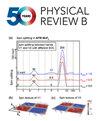SrNbO3薄膜的固有三维拓扑结构
IF 3.7
2区 物理与天体物理
Q1 Physics and Astronomy
引用次数: 0
摘要
过渡金属氧化物具有广泛的电子和磁性,为基于非常规量子现象(如拓扑相)开发未来电子学提供了一个非凡的平台。拓扑非平凡态的形成与晶体对称性、自旋轨道耦合和磁有序有关。本文采用角分辨光谱学(ARPES)和密度泛函理论(DFT)计算,证明了SrNbO3薄膜中的八面体旋转驱动了非琐碎能带拓扑的出现。具体来说,ARPES揭示和衍射数据证实了同相a0a0c+八面体旋转的存在,导致了拓扑保护的Dirac带交叉的形成,从而产生了该体系中的无质量费米子。我们的研究强调了过渡金属氧化物中结构扭曲的关键作用,说明了如何策略性地利用它们来解锁和稳定量子拓扑状态。这种方法有助于更广泛地理解量子材料及其在先进技术中的应用前景。2025年由美国物理学会出版本文章由计算机程序翻译,如有差异,请以英文原文为准。
Intrinsic three-dimensional topology in SrNbO3 films
Transition metal oxides, with their wide range of electronic and magnetic properties, offer a remarkable platform for developing future electronics based on unconventional quantum phenomena, such as topological phases. The formation of topologically nontrivial states is linked to crystalline symmetry, spin-orbit coupling, and magnetic ordering. Here, by employing angle-resolved photoemission spectroscopy (ARPES), supported by density functional theory (DFT) calculations, we demonstrated that intrinsic octahedral rotations in SrNbO3 films drive the emergence of non-trivial band topology. Specifically, ARPES reveals and diffraction data confirm the presence of in-phase a 0 a 0 c + Published by the American Physical Society 2025
求助全文
通过发布文献求助,成功后即可免费获取论文全文。
去求助
来源期刊

Physical Review B
物理-物理:凝聚态物理
CiteScore
6.70
自引率
32.40%
发文量
0
审稿时长
3.0 months
期刊介绍:
Physical Review B (PRB) is the world’s largest dedicated physics journal, publishing approximately 100 new, high-quality papers each week. The most highly cited journal in condensed matter physics, PRB provides outstanding depth and breadth of coverage, combined with unrivaled context and background for ongoing research by scientists worldwide.
PRB covers the full range of condensed matter, materials physics, and related subfields, including:
-Structure and phase transitions
-Ferroelectrics and multiferroics
-Disordered systems and alloys
-Magnetism
-Superconductivity
-Electronic structure, photonics, and metamaterials
-Semiconductors and mesoscopic systems
-Surfaces, nanoscience, and two-dimensional materials
-Topological states of matter
 求助内容:
求助内容: 应助结果提醒方式:
应助结果提醒方式:


